Latin America: inter-oceanic canals and railway lines (aka, Trump wants the Panama Canal back)
China built the Chancay Port in Peru and is managing it. Chancay port is fully-automated, equipped with unmanned cranes fabricated by Shanghai Zhenhua Heavy Industries (also known as ZPMC), driverless electric container trucks made by SAIC Motor, and 5G wireless control equipment from Huawei. All of the important equipment is from China.
The port is connected to the north-south Pan American Highway and from there to Brazil via the Southern Interoceanic Highway, which runs through Cuzco, Porto Velho in the upper Amazon basin, and all the way to Sao Paulo and Porto de Santos on the Atlantic coast.
There are plans afoot to build a railway for goods transport following a route between Chancay and Brazil although currently there are problems with feasibility studies as three countries, Peru, Bolivia and Brazil are involved. Bolivia will want the maximum benefit from this railway corridor. No doubt the problems will be overcome as Chancay Port itself had a fair share of problems, one being the interference of the usual suspects who cooked up a scheme that China certainly may not manage the port, but that they want to claw out a piece. It did not work. Mr Xi Jinping invited the Peruvian president for a pow-wow, treated her like royalty and she came back announcing .. No More Problems, even though she has no support in her country itself. It was quite a spectacular feat of diplomacy. This port is part of China’s Belt and Road initiative. With the direct connection to the Pan-American highway, basically, all countries in South America may find some benefit.
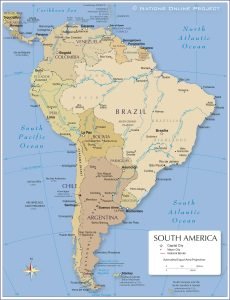
Chancay megaport magnifies China’s presence in South America
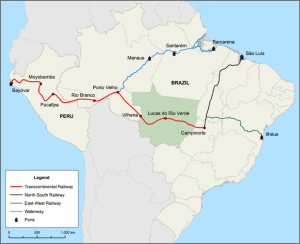
Stepping to Nicaragua in Central America. The latest announcement is that Nicaragua approached both China and Russia to figure out a way to build an inter-oceanic waterway for major ship traffic, similar to the Panama Canal but modernized, like the Chancay port. I’ve not heard the latest status of this as it has just happened, but this has been on the cards for years, each time stymied by US actions, either planting ‘environmental’ rumors or other types of societal control methods.
Now it looks like after the completion and commissioning of Chancey, and the first produce ships having reached Shangai, the Nicaraguan interoceanic channel has a better hope. There is a long history.
Attempts to build a canal across Nicaragua to connect the Atlantic Ocean with the Pacific Ocean stretch back to the early colonial era. Construction of such a shipping route—using the San Juan River as an access route to Lake Nicaragua—was first proposed then. Napoleon III wrote an article about its feasibility in the middle of the 19th century. The United States abandoned plans to construct a waterway in Nicaragua in the early 20th century after it purchased the French interests in the Panama Canal, which has served as the main connecting route across Central America since its completion.
Because the steady increase in world shipping may make it an economically viable project, speculation on a new shipping route has continued. In June 2013, Nicaragua’s National Assembly approved a bill to grant a 50-year concession to the Hong Kong Nicaragua Canal Development Investment Company (HKND Group) to manage the Nicaraguan Canal and Development Project to build the canal, but little development took place, and the concession to HKND was canceled in May 2024. This has now changed as Chancay demonstrated without a doubt that this kind of route is not only possible, but highly encouraged.
Now we get to the Panama Canal. The Canal had trouble with drought during the last two years and transit shipping through it was curtailed to a great extent and cost for transit soared. They’ve had rain since and traffic is slowly increasing.
I once sailed there, and we wanted to pass through the Canal just because we could, but the cost was too high and I was scared to be tied to a massive cargo ship and with it, go through the differences in water height from one ocean to the other, dipping with the cargo ship into locks that pumped out the water, and then, in the next one, rise with the container ship until someone remembered to throw the lines and let us loose – only to repeat the experience to get back to the Caribbean and the Pacific Ocean.
The American influence in the Canal Zone in Panama is large with literally a little US for the personnel who are American and could care a fig about Panama. The history of the Panama Canal is fascinating. This interoceanic waterway has been functional since the early 1900’s.
To the history, in 1850 the United States and Great Britain negotiated the Clayton-Bulwer Treaty to rein in rivalry over a proposed canal through the Central American Republic of Nicaragua. The Anglo-American canal, however, never went beyond the planning stages. French attempts to build a canal through Panama (province of Colombia) advanced further. Led by Ferdinand de Lesseps—the builder of the Suez Canal in Egypt—the French began excavating in 1880. Malaria, yellow fever, and other tropical diseases conspired against the de Lesseps campaign and after 9 years and a loss of approximately 20,000 lives, the French attempt went bankrupt. In spite of such setbacks, American interest in a canal continued unabated. The Hay-Pauncefote Treaty of 1901 abrogated the earlier Clayton-Bulwer Treaty and licensed the United States to build and manage its own canal. Following heated debate over the location of the proposed canal, on June 19, 1902, the U.S. Senate voted in favor of building the canal through Panama. Within 6 months, Secretary of State John Hay signed a treaty with Colombian Foreign Minister Tomás Herrán to build the new canal. The financial terms were unacceptable to Colombia’s congress, and it rejected the offer.
President Roosevelt responded by dispatching U.S. warships to Panama City (on the Pacific) and Colón (on the Atlantic) in support of Panamanian independence. Colombian troops were unable to negotiate the jungles of the Darien Strait and Panama declared independence on November 3, 1903. The newly declared Republic of Panama immediately named Philippe Bunau-Varilla (a French engineer who had been involved in the earlier de Lesseps canal attempt) as Envoy Extraordinary and Minister Plenipotentiary. In his new role, Bunau-Varilla negotiated the Hay-Bunau-Varilla Treaty of 1903, which provided the United States with a 10-mile wide strip of land for the canal, a one-time $10 million payment to Panama, and an annual annuity of $250,000. The United States also agreed to guarantee the independence of Panama. (This came after around 100 years of a fight for freedom against Spain in the Latin Americas. Completed in 1914, the Panama Canal symbolized U.S. technological prowess and economic power. Although U.S. control of the canal eventually became an irritant to U.S.-Panamanian relations, at the time it was heralded as a major foreign policy achievement.
Jimmy Carter for his reasons, gave the Canal to Panama for 1 Dollar (says Trump) and according to all treaties and agreements the Panama Canal belongs to Panama.
What happened over the years is that Panama gathered a sizable Chinese population. Of course, the Chinese were never hesitant of tackling the most serious of building jobs but labor was recruited from everywhere. The first Chinese who immigrated brought their culture and customs. Those early immigrants were a group of Chinese workers—705 total—who landed in Panama on March 30, 1854, to work for the Panama Railroad Company. “Since then, the Chinese never stopped immigrating,” says Esteban Cheung, a Panamanian-Chinese communication consultant based in Panama City. Today, one in five Panamanians can claim some form of Chinese ancestry. There are dozens of festivals and events that allow Panamanian-Chinese to celebrate and share their heritage. The community is vibrant, and they follow all of the Chinese High Days like Dragon Boat Races and Chinese New Year. Conde Nast says the best Dim Sum in the western hemisphere can be found in Panama City. Today Panama is home to one of the largest and oldest Chinese communities in South America, and the most vibrant Chinese enclaves shine in the country’s capital of Panama City.
Now to the current:
US, China clash over the neutrality of drought-hit Panama Canal in January 2024
As the Panama Canal recovers from a drought that, as recently as October, threatened to halve the usual number of available slots and has pushed rates sky-high, the vital waterway has also become a geopolitical flashpoint. Behind the scenes, China and the US are involved in a diplomatic and commercial tussle over the neutrality of the canal. Little has changed since. More recently, high-ranking US Navy officers are expressing fears that China is using its growing political and commercial influence over the canal and Panama to extend its Belt and Road initiative more deeply into South America. (Of course, of course, this is accurate).
The US ambassador to Panama, Mari Carmen Aponte, is also concerned at developments. “We do not want to put Panama in a situation where they have to choose between the United States and the People’s Republic of China,” she told Panama TV in early 2023.
Currently, China controls two of Panama’s five principal zone ports through Hong Kong-based Hutchison, with one on each side of the waterway at Balboa and Cristobal. Chinese companies are finishing work on the Amador Pacific Coast cruise terminal. These follow China-based Landbridge buying control of Margarita Island, Panama’s largest port on the Atlantic side, for US$900M in 2016 and China Communications Construction’s building of a deepwater port.
According to US trade publication Engineering News-Record, a consortium of Chinese state-owned firms will soon restart construction of a fourth US$1.3Bn bridge across the Canal after at least five years of disputes. Like other Chinese-initiated projects, the contract for the fourth bridge was signed by Panamanian President Juan Carlos Varela who had, at Beijing’s behest, repudiated Panama’s recognition of Taiwan as a separate country. As Engineering News-Record reports, “Having already ended Panama’s relationship with Taiwan and establishing official diplomatic ties with Beijing in 2017, President Varela made deals with other Chinese companies to build a US$4Bn high-speed rail line connecting Panama City with Costa Rica, US$1Bn in port facilities, an electrical transmission project, convention center,r and other facilities.” Container ships have accounted for 425 or 57.8% of the neoPanamax transits in fiscal year 2024 (source: PCA)
Projects dropped
However, many of these projects were dropped or modified after Mr Varela was ousted by current President Laurentino Cortizo. “His policies have been more favorable to US interests”. Also, a little-known flying visit to Panama City by former Secretary of State Mike Pompeo helped force a rethink.
But China is already well entrenched in the canal. Numerous Chinese companies including Huawei have set up regional distribution hubs in the Panama Pacific free trade zone and at least four Chinese banks have licences in Panama.
Land bridge status
Bigger than all these though would be a land bridge – a ’dry channel’ – that would provide an alternative to the Panama Canal, according to the Chinese and Colombian governments that are championing the project. According to Colombian President Gustavo Petro, also an economist, the project is “very advanced”. If it happens (and there are many sceptics), the land bridge would connect the port of Buenaventura with the Atlantic by a rail link.
Most of China’s inroads into the Canal happened under the noses of the Trump administration, and the Biden White House has been trying to unravel those it can, given the economic importance to the US of the waterway that it ceded to Panama in 1999 on condition it remained politically neutral “with fair access to all nations and non-discriminatory tolls”.
Vital link for US container traffic
The IMF points out, “In fiscal year 2021, the United States was the origin or destination of 72.5% of all ships crossing the canal. China came in second, with 22.1% of the traffic being ships from China. Japan followed closely with 14.7%.” In normal times about 1,000 ships pass through the 64 km-long canal each month carrying some 40M tonnes of goods. The canal is vital link to US cargo, accounting for about 40% of US container traffic annually. And the drought conditions at the canal have also forced some container shipping lines to seek a land-based alternative for moving their cargo.
In an advisory to its clients on 12 January, box shipping giant Maersk said it was shifting container cargo transiting from Australia and New Zealand to the US East Coast that would normally pass through the canal to the Panama Canal Railway “to safeguard its customers’ supply chains”.
Relief ahead?
It looks as though the problems posed to shipping by the drought-affected canal — and exacerbated by the attacks on vessels in the Red Sea — may be easing. Rains finally began to fall on Gatun Lake, a major source of water for the locks, following the driest October on record for the canal’s watershed.
As the lake began to fill, the canal authority felt able to increase the number of daily transits to 24 from January, up from the limit of 18 it was going to impose from February and two more than through December. Although 24 a day is about 12 less than the usual number, it is an important improvement.
Some shipping is affected more than others. According to the canal authority, the dry bulk and LNG sectors are the hardest-hit by the transit limits while container ships are the least-affected because up to 70% of those using the canal can handle a maximum draught of 13.4 m.
Container ships have accounted for 285 or 15.9% of the Panamax transits, and 425 or 57.8% of the neoPanamax transits during the three months of fiscal year 2024, according to Panama Canal Authority data.
Saving water
As the lake ran dry, the canal authority imposed a series of water-saving and operational measures. The introduction of drought restrictions means neoPanamax vessels were allowed maximum draughts of up to 13.4 m. A technique called cross-filling meant water could be sent from one lock chamber to another, a strategy that saved the equivalent consumption of six daily transits. Tandem lockages meant that two ships could share one chamber provided the size of the vessels allowed it. And among other measures the authority tightened up on water leaks in valves and gates. “In the neoPanamax locks the direction and scheduling of transits are analysed to make the most of every drop of this resource,” summarises the authority, citing water savings of as much as 50%.
However, although the authority has done all it can, trade routes will suffer for months to come, predicts PortWatch, a new open platform launched by the IMF and University of Oxford. “Ports in Panama, Nicaragua, Ecuador, Peru, El Salvador and Jamaica are suffering most from these delays, with 10-25% of their total maritime trade flows affected.”
And at this time, Mr Trump seemingly became aware that something was happening and he claims “They are so unfair to us”. The Panama Canal was built for the US and now, what do we have there. Yes, China. https://t.me/VanessaBeeley/34848
In the meantime the Canal has been expanded and doubled in capacity, to be able to carry the NewPanamex size larger ships and increase the throughput.
“WE WILL NEVER EVER LET IT (PANAMA CANAL) FALL INTO THE WRONG HANDS.” President @RealDonaldTrump
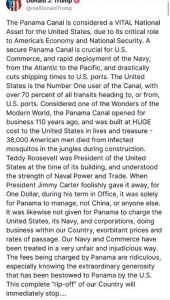
Mr Trump, we are in a world of multipolarity now. We’re connecting the nodes. Why don’t you fix the US and negotiate with Panama, who owns the Panama Canal, for whatever you need? You may have to negotiate with China as well, ’cause they’re eating your lunch and there is nothing you can do about it. Perhaps ask very nicely If a US consortium may participate in the building of the Nicaragua Channel.

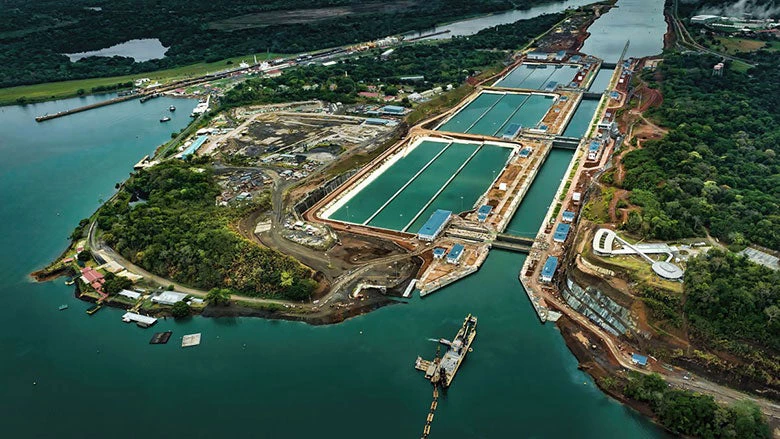


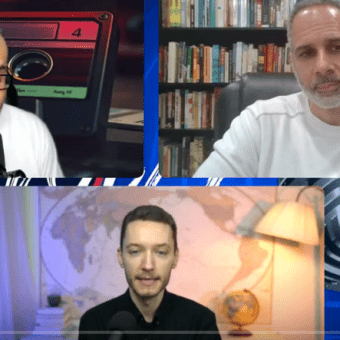
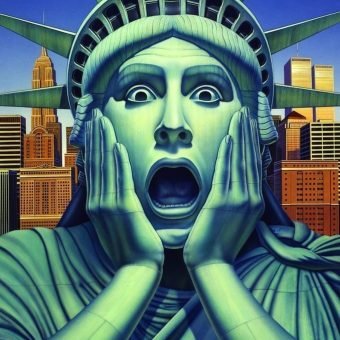
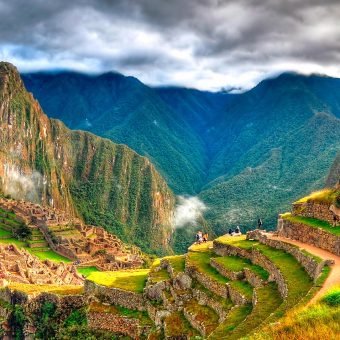

Donald Trump is the perfect ruler for America, as he more nakedly represents American values in all their narcissistic and sociopathic glory. Simply put, Americans believe that they have a God-Given right to own and dominate the world. Any nation that challenges the USA’s global rule triggers the Americans into… Read more »
This is quite a comprehensive treatise on the Canal. Thank you, Amarynth, your knowledge and affection for this region is noticeable.
Thanks, Amarynth – what a great reference piece.
In the meantime, I’m scratching my head, and trying to think of a single country that the Trumpster hasn’t threatened in the last few weeks.
Season’s greeting
Col
great work, amarynth. kudos, applause & gratitude.